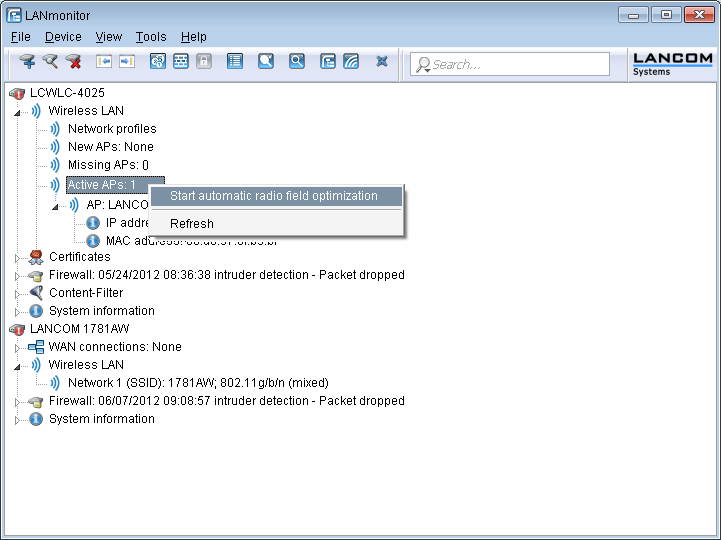Selecting the channel from the channel list defines a portion of the frequency band that an AP uses for its logical wireless LANs. All WLAN clients that need to connect to an AP have to use the same channel on the same frequency band. The 2.4-GHz band works with channels 1 to 13 (depending on the country) and the 5-GHz band works with channels 36 to 64. On each of these channels, only one AP can actually transfer data. In order to operate another AP within radio range with maximum bandwidth, the AP must make use of a separate channel—otherwise all of the participating WLANs have to share the channel's bandwidth.
In larger installations with several APs it can be difficult to set a channel for every AP. With automatic radio-field (RF) optimization, the WLCs provide an automatic method of setting the optimum channels for APs that work in the 2.4-GHz band and 5-GHz band.
Command line:
LANmonitor: Right-click on the list of active APs or on a specific device, and in the context menu select Start automatic RF optimization.

Optimization is then carried out in the following stages:
- The WLC assigns the same channel to all APs. The selected channel is the one being used by the majority of APs.
- The APs carry out a background scan and report the results to the WLC.
- Based on the devices found by the background scan, the WLC sets an interference value for each AP.
- It then deletes the AP channel list for all APs. With the channel list now empty, each AP receives a configuration update with a new channel list for its respective profile.
- The WLC disables the radio modules of all APs.
- The individual APs now go through the following sequence. This begins with the AP with the highest interference value being the first to select a channel.
- In the order of the interference values the WLC enables the radio modules in the APs, which then start their automatic calibration. Each AP automatically searches for the best channel from the channel list assigned to it. To determine which channel is the best, the AP scans for interference in order to allow for the signal strengths and channels occupied by other APs. Because the former list in the WLC configuration was deleted, this is now the profile channel list. If the profile channel list is empty, then the AP has freedom of choice from the channels that are not occupied by other radio modules. The selected channel is then communicated back to the WLC and entered into the AP channel list there. For this reason, the AP receives the same channel the next time a connection is established. The AP channel list has a higher weighting than the profile channel list.
